IBUS 1302 Principles of Import Business Plan: Toyota Aygo in the USA
VerifiedAdded on 2023/06/03
|8
|1840
|359
Report
AI Summary
This report presents an import business plan for the Toyota Aygo, focusing on its introduction to the USA market. It begins with a company description of Toyota Motor Corporation, including its organizational structure, mission, and customer base. The report then delves into market research, analyzing the industry, competitors, and competitive advantages. It includes details on product lines, pricing strategies, and the product life cycle, and also explores intellectual property rights and research and development. Furthermore, the report covers marketing and sales strategies, financial projections including profit and loss, cash flow, and balance sheets, as well as break-even analysis and financial assumptions. Finally, the report outlines necessary import documentation and shipment details, providing a comprehensive overview of the import business plan for the Toyota Aygo.
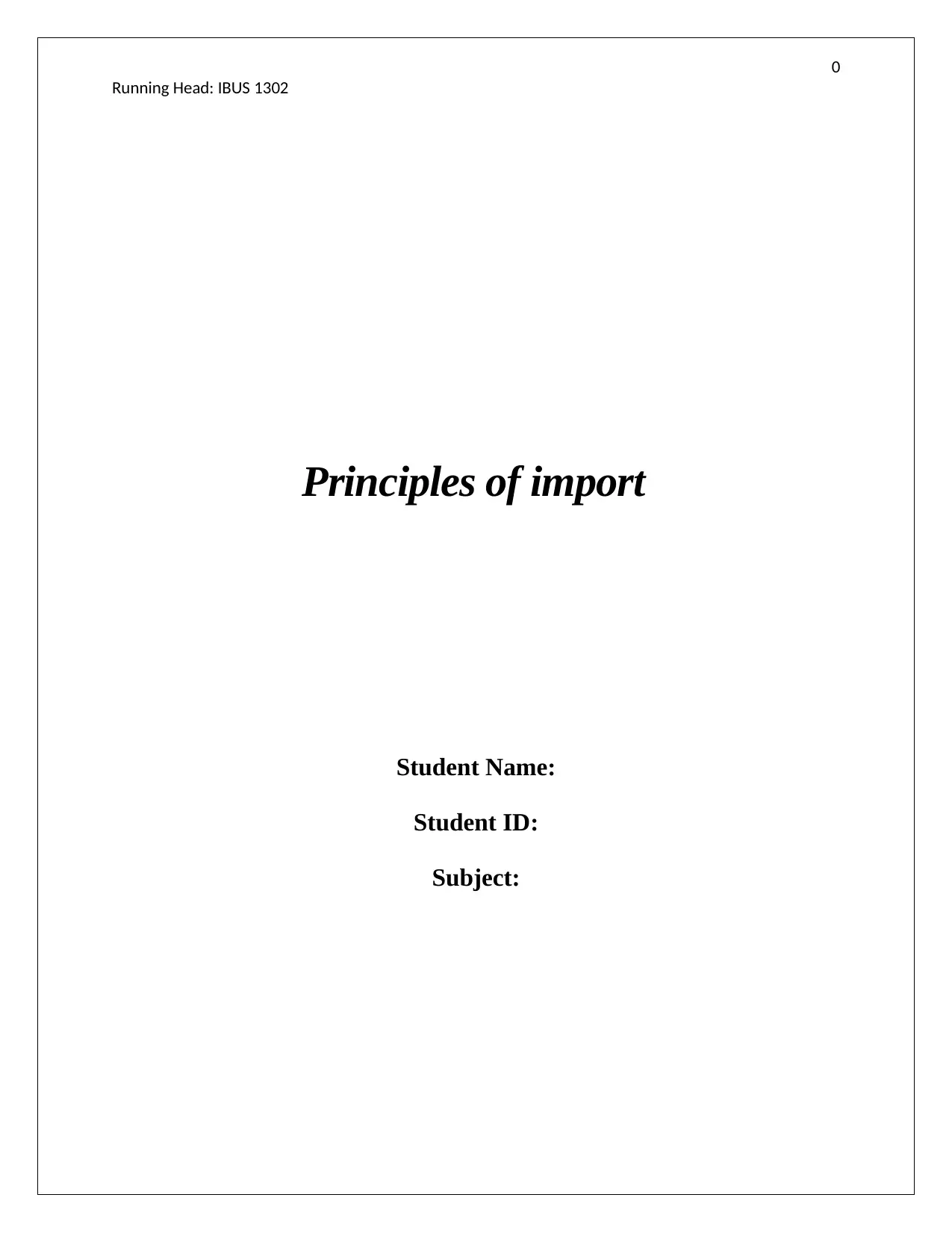
0
Running Head: IBUS 1302
Principles of import
Student Name:
Student ID:
Subject:
Running Head: IBUS 1302
Principles of import
Student Name:
Student ID:
Subject:
Paraphrase This Document
Need a fresh take? Get an instant paraphrase of this document with our AI Paraphraser
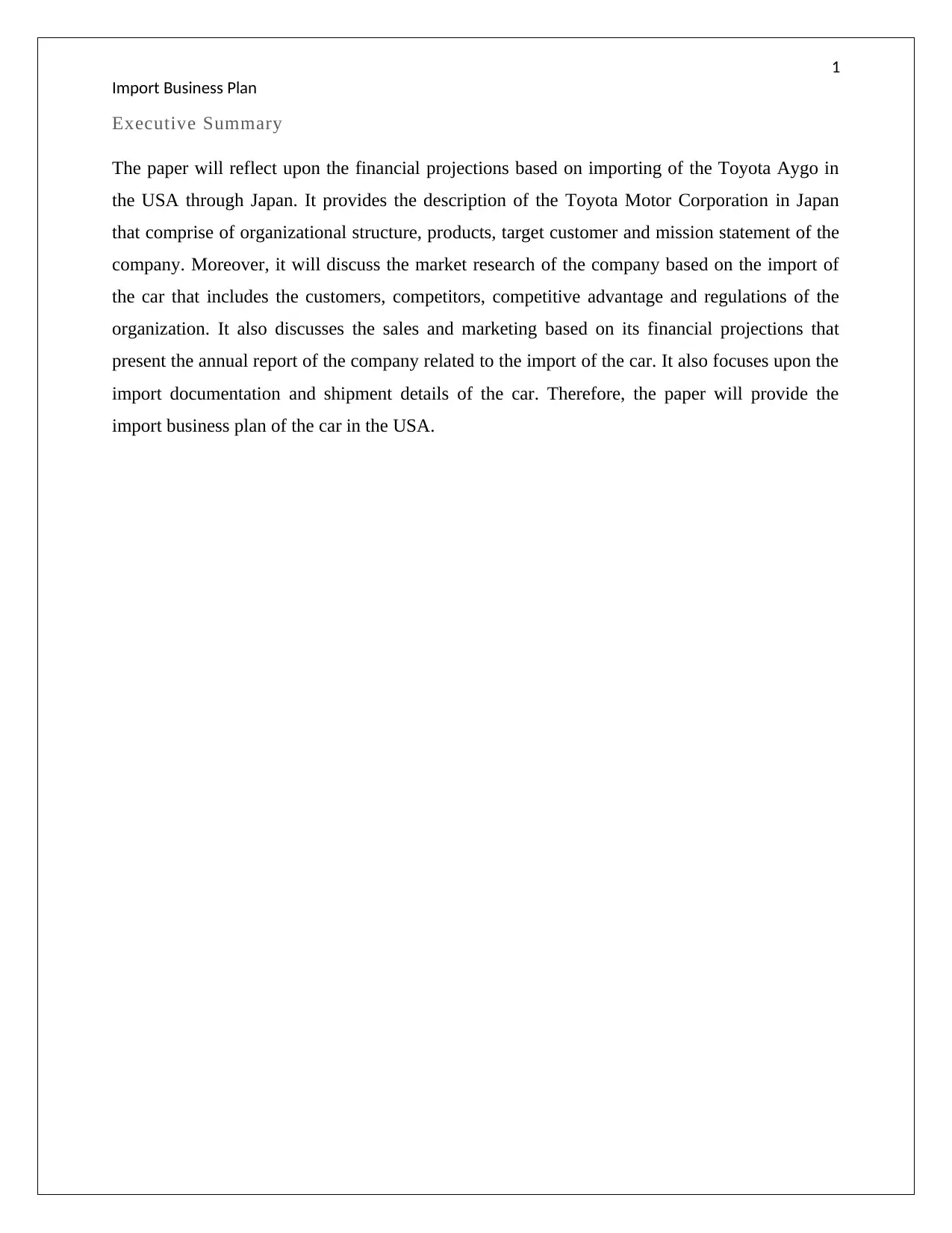
1
Import Business Plan
Executive Summary
The paper will reflect upon the financial projections based on importing of the Toyota Aygo in
the USA through Japan. It provides the description of the Toyota Motor Corporation in Japan
that comprise of organizational structure, products, target customer and mission statement of the
company. Moreover, it will discuss the market research of the company based on the import of
the car that includes the customers, competitors, competitive advantage and regulations of the
organization. It also discusses the sales and marketing based on its financial projections that
present the annual report of the company related to the import of the car. It also focuses upon the
import documentation and shipment details of the car. Therefore, the paper will provide the
import business plan of the car in the USA.
Import Business Plan
Executive Summary
The paper will reflect upon the financial projections based on importing of the Toyota Aygo in
the USA through Japan. It provides the description of the Toyota Motor Corporation in Japan
that comprise of organizational structure, products, target customer and mission statement of the
company. Moreover, it will discuss the market research of the company based on the import of
the car that includes the customers, competitors, competitive advantage and regulations of the
organization. It also discusses the sales and marketing based on its financial projections that
present the annual report of the company related to the import of the car. It also focuses upon the
import documentation and shipment details of the car. Therefore, the paper will provide the
import business plan of the car in the USA.
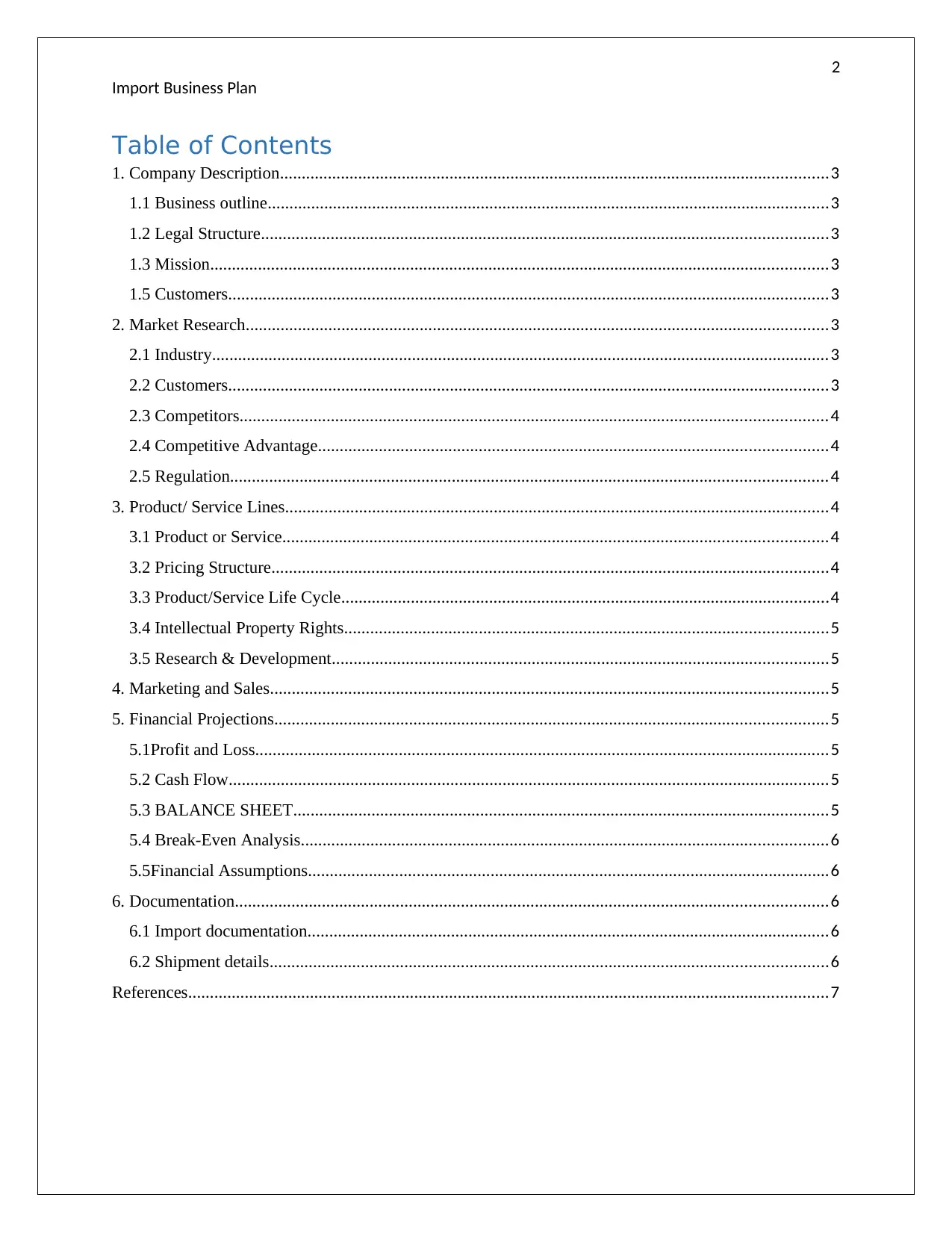
2
Import Business Plan
Table of Contents
1. Company Description..............................................................................................................................3
1.1 Business outline.................................................................................................................................3
1.2 Legal Structure..................................................................................................................................3
1.3 Mission..............................................................................................................................................3
1.5 Customers..........................................................................................................................................3
2. Market Research......................................................................................................................................3
2.1 Industry..............................................................................................................................................3
2.2 Customers..........................................................................................................................................3
2.3 Competitors.......................................................................................................................................4
2.4 Competitive Advantage.....................................................................................................................4
2.5 Regulation.........................................................................................................................................4
3. Product/ Service Lines.............................................................................................................................4
3.1 Product or Service.............................................................................................................................4
3.2 Pricing Structure................................................................................................................................4
3.3 Product/Service Life Cycle................................................................................................................4
3.4 Intellectual Property Rights...............................................................................................................5
3.5 Research & Development..................................................................................................................5
4. Marketing and Sales................................................................................................................................5
5. Financial Projections...............................................................................................................................5
5.1Profit and Loss....................................................................................................................................5
5.2 Cash Flow..........................................................................................................................................5
5.3 BALANCE SHEET...........................................................................................................................5
5.4 Break-Even Analysis.........................................................................................................................6
5.5Financial Assumptions........................................................................................................................6
6. Documentation........................................................................................................................................6
6.1 Import documentation........................................................................................................................6
6.2 Shipment details................................................................................................................................6
References...................................................................................................................................................7
Import Business Plan
Table of Contents
1. Company Description..............................................................................................................................3
1.1 Business outline.................................................................................................................................3
1.2 Legal Structure..................................................................................................................................3
1.3 Mission..............................................................................................................................................3
1.5 Customers..........................................................................................................................................3
2. Market Research......................................................................................................................................3
2.1 Industry..............................................................................................................................................3
2.2 Customers..........................................................................................................................................3
2.3 Competitors.......................................................................................................................................4
2.4 Competitive Advantage.....................................................................................................................4
2.5 Regulation.........................................................................................................................................4
3. Product/ Service Lines.............................................................................................................................4
3.1 Product or Service.............................................................................................................................4
3.2 Pricing Structure................................................................................................................................4
3.3 Product/Service Life Cycle................................................................................................................4
3.4 Intellectual Property Rights...............................................................................................................5
3.5 Research & Development..................................................................................................................5
4. Marketing and Sales................................................................................................................................5
5. Financial Projections...............................................................................................................................5
5.1Profit and Loss....................................................................................................................................5
5.2 Cash Flow..........................................................................................................................................5
5.3 BALANCE SHEET...........................................................................................................................5
5.4 Break-Even Analysis.........................................................................................................................6
5.5Financial Assumptions........................................................................................................................6
6. Documentation........................................................................................................................................6
6.1 Import documentation........................................................................................................................6
6.2 Shipment details................................................................................................................................6
References...................................................................................................................................................7
⊘ This is a preview!⊘
Do you want full access?
Subscribe today to unlock all pages.

Trusted by 1+ million students worldwide
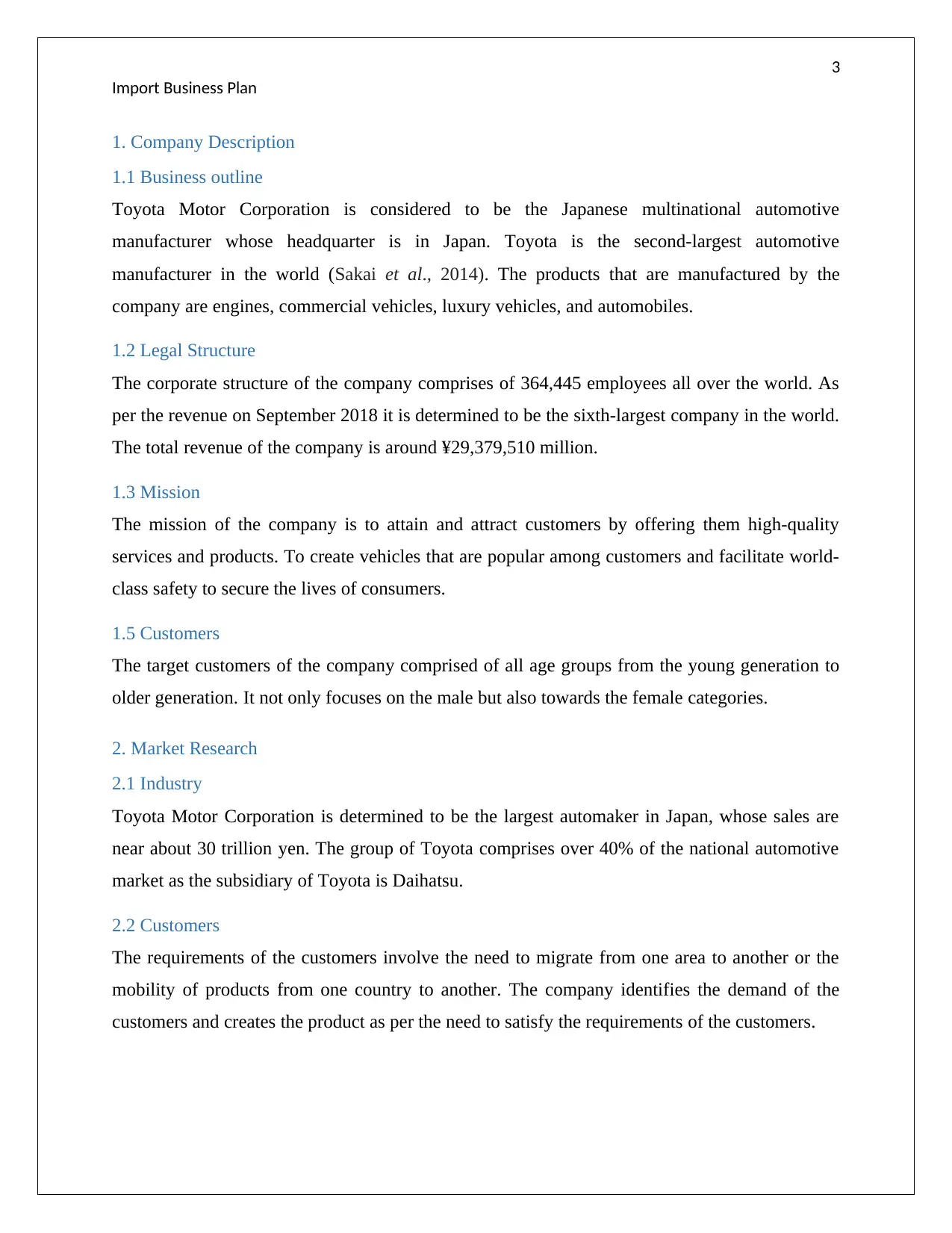
3
Import Business Plan
1. Company Description
1.1 Business outline
Toyota Motor Corporation is considered to be the Japanese multinational automotive
manufacturer whose headquarter is in Japan. Toyota is the second-largest automotive
manufacturer in the world (Sakai et al., 2014). The products that are manufactured by the
company are engines, commercial vehicles, luxury vehicles, and automobiles.
1.2 Legal Structure
The corporate structure of the company comprises of 364,445 employees all over the world. As
per the revenue on September 2018 it is determined to be the sixth-largest company in the world.
The total revenue of the company is around ¥29,379,510 million.
1.3 Mission
The mission of the company is to attain and attract customers by offering them high-quality
services and products. To create vehicles that are popular among customers and facilitate world-
class safety to secure the lives of consumers.
1.5 Customers
The target customers of the company comprised of all age groups from the young generation to
older generation. It not only focuses on the male but also towards the female categories.
2. Market Research
2.1 Industry
Toyota Motor Corporation is determined to be the largest automaker in Japan, whose sales are
near about 30 trillion yen. The group of Toyota comprises over 40% of the national automotive
market as the subsidiary of Toyota is Daihatsu.
2.2 Customers
The requirements of the customers involve the need to migrate from one area to another or the
mobility of products from one country to another. The company identifies the demand of the
customers and creates the product as per the need to satisfy the requirements of the customers.
Import Business Plan
1. Company Description
1.1 Business outline
Toyota Motor Corporation is considered to be the Japanese multinational automotive
manufacturer whose headquarter is in Japan. Toyota is the second-largest automotive
manufacturer in the world (Sakai et al., 2014). The products that are manufactured by the
company are engines, commercial vehicles, luxury vehicles, and automobiles.
1.2 Legal Structure
The corporate structure of the company comprises of 364,445 employees all over the world. As
per the revenue on September 2018 it is determined to be the sixth-largest company in the world.
The total revenue of the company is around ¥29,379,510 million.
1.3 Mission
The mission of the company is to attain and attract customers by offering them high-quality
services and products. To create vehicles that are popular among customers and facilitate world-
class safety to secure the lives of consumers.
1.5 Customers
The target customers of the company comprised of all age groups from the young generation to
older generation. It not only focuses on the male but also towards the female categories.
2. Market Research
2.1 Industry
Toyota Motor Corporation is determined to be the largest automaker in Japan, whose sales are
near about 30 trillion yen. The group of Toyota comprises over 40% of the national automotive
market as the subsidiary of Toyota is Daihatsu.
2.2 Customers
The requirements of the customers involve the need to migrate from one area to another or the
mobility of products from one country to another. The company identifies the demand of the
customers and creates the product as per the need to satisfy the requirements of the customers.
Paraphrase This Document
Need a fresh take? Get an instant paraphrase of this document with our AI Paraphraser
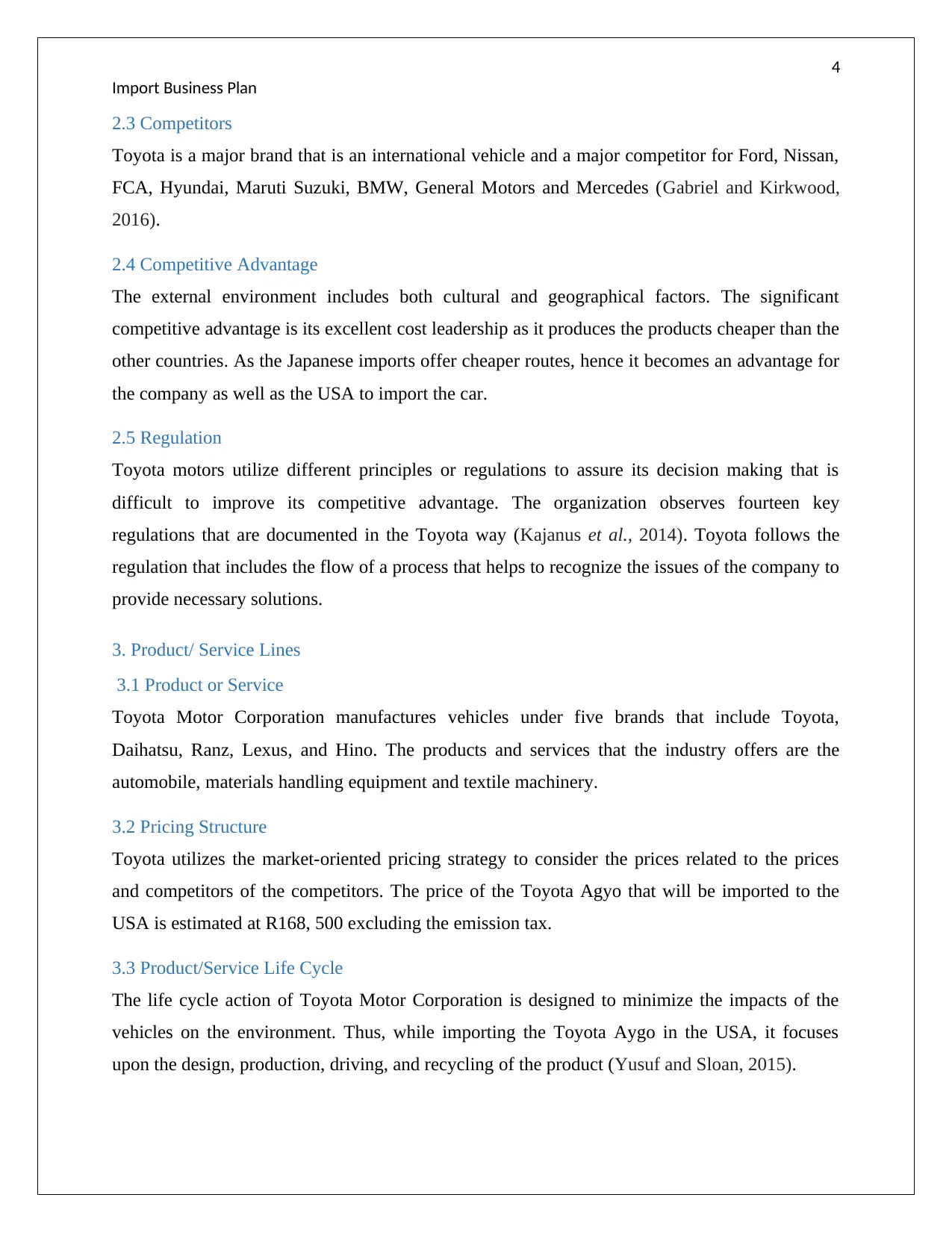
4
Import Business Plan
2.3 Competitors
Toyota is a major brand that is an international vehicle and a major competitor for Ford, Nissan,
FCA, Hyundai, Maruti Suzuki, BMW, General Motors and Mercedes (Gabriel and Kirkwood,
2016).
2.4 Competitive Advantage
The external environment includes both cultural and geographical factors. The significant
competitive advantage is its excellent cost leadership as it produces the products cheaper than the
other countries. As the Japanese imports offer cheaper routes, hence it becomes an advantage for
the company as well as the USA to import the car.
2.5 Regulation
Toyota motors utilize different principles or regulations to assure its decision making that is
difficult to improve its competitive advantage. The organization observes fourteen key
regulations that are documented in the Toyota way (Kajanus et al., 2014). Toyota follows the
regulation that includes the flow of a process that helps to recognize the issues of the company to
provide necessary solutions.
3. Product/ Service Lines
3.1 Product or Service
Toyota Motor Corporation manufactures vehicles under five brands that include Toyota,
Daihatsu, Ranz, Lexus, and Hino. The products and services that the industry offers are the
automobile, materials handling equipment and textile machinery.
3.2 Pricing Structure
Toyota utilizes the market-oriented pricing strategy to consider the prices related to the prices
and competitors of the competitors. The price of the Toyota Agyo that will be imported to the
USA is estimated at R168, 500 excluding the emission tax.
3.3 Product/Service Life Cycle
The life cycle action of Toyota Motor Corporation is designed to minimize the impacts of the
vehicles on the environment. Thus, while importing the Toyota Aygo in the USA, it focuses
upon the design, production, driving, and recycling of the product (Yusuf and Sloan, 2015).
Import Business Plan
2.3 Competitors
Toyota is a major brand that is an international vehicle and a major competitor for Ford, Nissan,
FCA, Hyundai, Maruti Suzuki, BMW, General Motors and Mercedes (Gabriel and Kirkwood,
2016).
2.4 Competitive Advantage
The external environment includes both cultural and geographical factors. The significant
competitive advantage is its excellent cost leadership as it produces the products cheaper than the
other countries. As the Japanese imports offer cheaper routes, hence it becomes an advantage for
the company as well as the USA to import the car.
2.5 Regulation
Toyota motors utilize different principles or regulations to assure its decision making that is
difficult to improve its competitive advantage. The organization observes fourteen key
regulations that are documented in the Toyota way (Kajanus et al., 2014). Toyota follows the
regulation that includes the flow of a process that helps to recognize the issues of the company to
provide necessary solutions.
3. Product/ Service Lines
3.1 Product or Service
Toyota Motor Corporation manufactures vehicles under five brands that include Toyota,
Daihatsu, Ranz, Lexus, and Hino. The products and services that the industry offers are the
automobile, materials handling equipment and textile machinery.
3.2 Pricing Structure
Toyota utilizes the market-oriented pricing strategy to consider the prices related to the prices
and competitors of the competitors. The price of the Toyota Agyo that will be imported to the
USA is estimated at R168, 500 excluding the emission tax.
3.3 Product/Service Life Cycle
The life cycle action of Toyota Motor Corporation is designed to minimize the impacts of the
vehicles on the environment. Thus, while importing the Toyota Aygo in the USA, it focuses
upon the design, production, driving, and recycling of the product (Yusuf and Sloan, 2015).
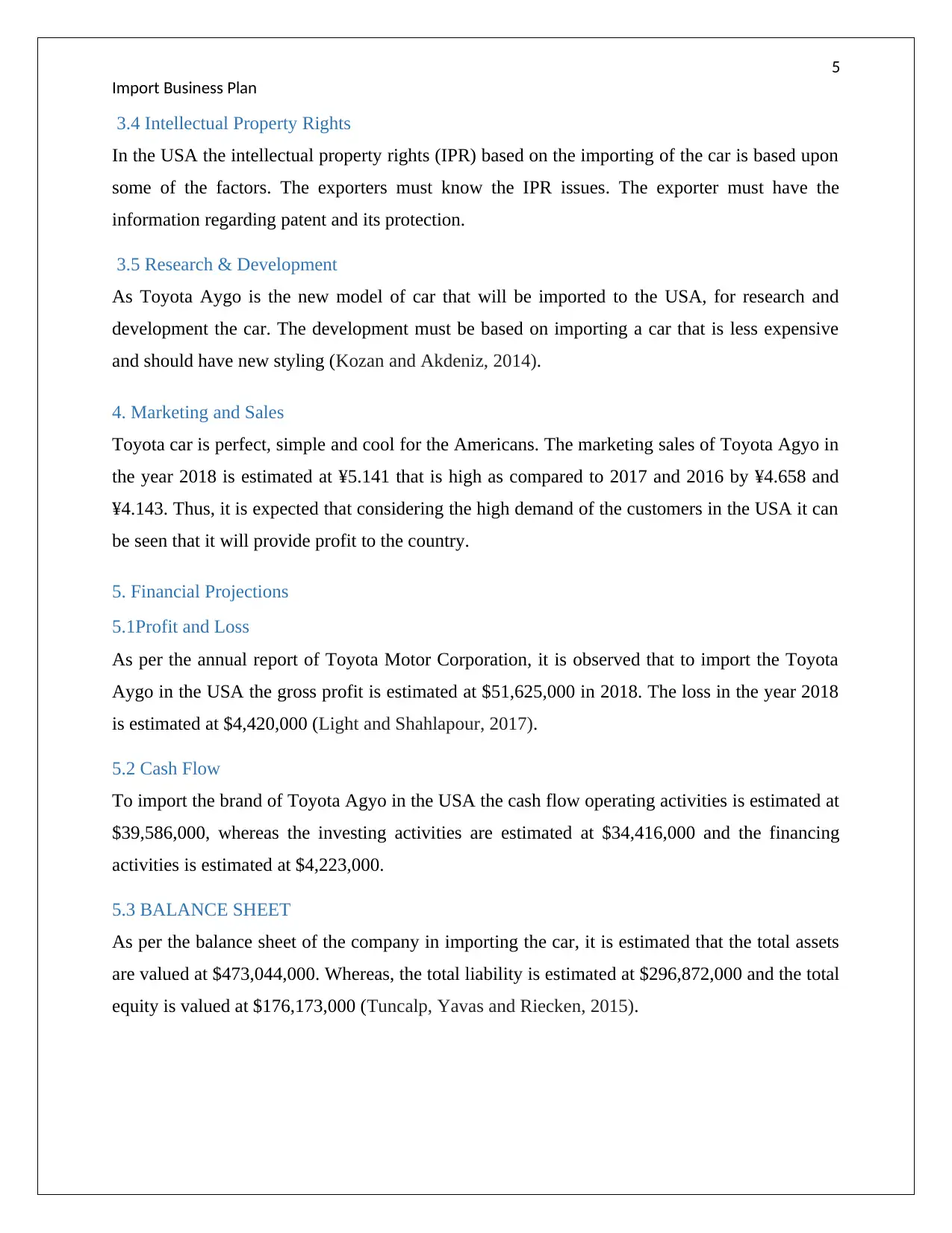
5
Import Business Plan
3.4 Intellectual Property Rights
In the USA the intellectual property rights (IPR) based on the importing of the car is based upon
some of the factors. The exporters must know the IPR issues. The exporter must have the
information regarding patent and its protection.
3.5 Research & Development
As Toyota Aygo is the new model of car that will be imported to the USA, for research and
development the car. The development must be based on importing a car that is less expensive
and should have new styling (Kozan and Akdeniz, 2014).
4. Marketing and Sales
Toyota car is perfect, simple and cool for the Americans. The marketing sales of Toyota Agyo in
the year 2018 is estimated at ¥5.141 that is high as compared to 2017 and 2016 by ¥4.658 and
¥4.143. Thus, it is expected that considering the high demand of the customers in the USA it can
be seen that it will provide profit to the country.
5. Financial Projections
5.1Profit and Loss
As per the annual report of Toyota Motor Corporation, it is observed that to import the Toyota
Aygo in the USA the gross profit is estimated at $51,625,000 in 2018. The loss in the year 2018
is estimated at $4,420,000 (Light and Shahlapour, 2017).
5.2 Cash Flow
To import the brand of Toyota Agyo in the USA the cash flow operating activities is estimated at
$39,586,000, whereas the investing activities are estimated at $34,416,000 and the financing
activities is estimated at $4,223,000.
5.3 BALANCE SHEET
As per the balance sheet of the company in importing the car, it is estimated that the total assets
are valued at $473,044,000. Whereas, the total liability is estimated at $296,872,000 and the total
equity is valued at $176,173,000 (Tuncalp, Yavas and Riecken, 2015).
Import Business Plan
3.4 Intellectual Property Rights
In the USA the intellectual property rights (IPR) based on the importing of the car is based upon
some of the factors. The exporters must know the IPR issues. The exporter must have the
information regarding patent and its protection.
3.5 Research & Development
As Toyota Aygo is the new model of car that will be imported to the USA, for research and
development the car. The development must be based on importing a car that is less expensive
and should have new styling (Kozan and Akdeniz, 2014).
4. Marketing and Sales
Toyota car is perfect, simple and cool for the Americans. The marketing sales of Toyota Agyo in
the year 2018 is estimated at ¥5.141 that is high as compared to 2017 and 2016 by ¥4.658 and
¥4.143. Thus, it is expected that considering the high demand of the customers in the USA it can
be seen that it will provide profit to the country.
5. Financial Projections
5.1Profit and Loss
As per the annual report of Toyota Motor Corporation, it is observed that to import the Toyota
Aygo in the USA the gross profit is estimated at $51,625,000 in 2018. The loss in the year 2018
is estimated at $4,420,000 (Light and Shahlapour, 2017).
5.2 Cash Flow
To import the brand of Toyota Agyo in the USA the cash flow operating activities is estimated at
$39,586,000, whereas the investing activities are estimated at $34,416,000 and the financing
activities is estimated at $4,223,000.
5.3 BALANCE SHEET
As per the balance sheet of the company in importing the car, it is estimated that the total assets
are valued at $473,044,000. Whereas, the total liability is estimated at $296,872,000 and the total
equity is valued at $176,173,000 (Tuncalp, Yavas and Riecken, 2015).
⊘ This is a preview!⊘
Do you want full access?
Subscribe today to unlock all pages.

Trusted by 1+ million students worldwide
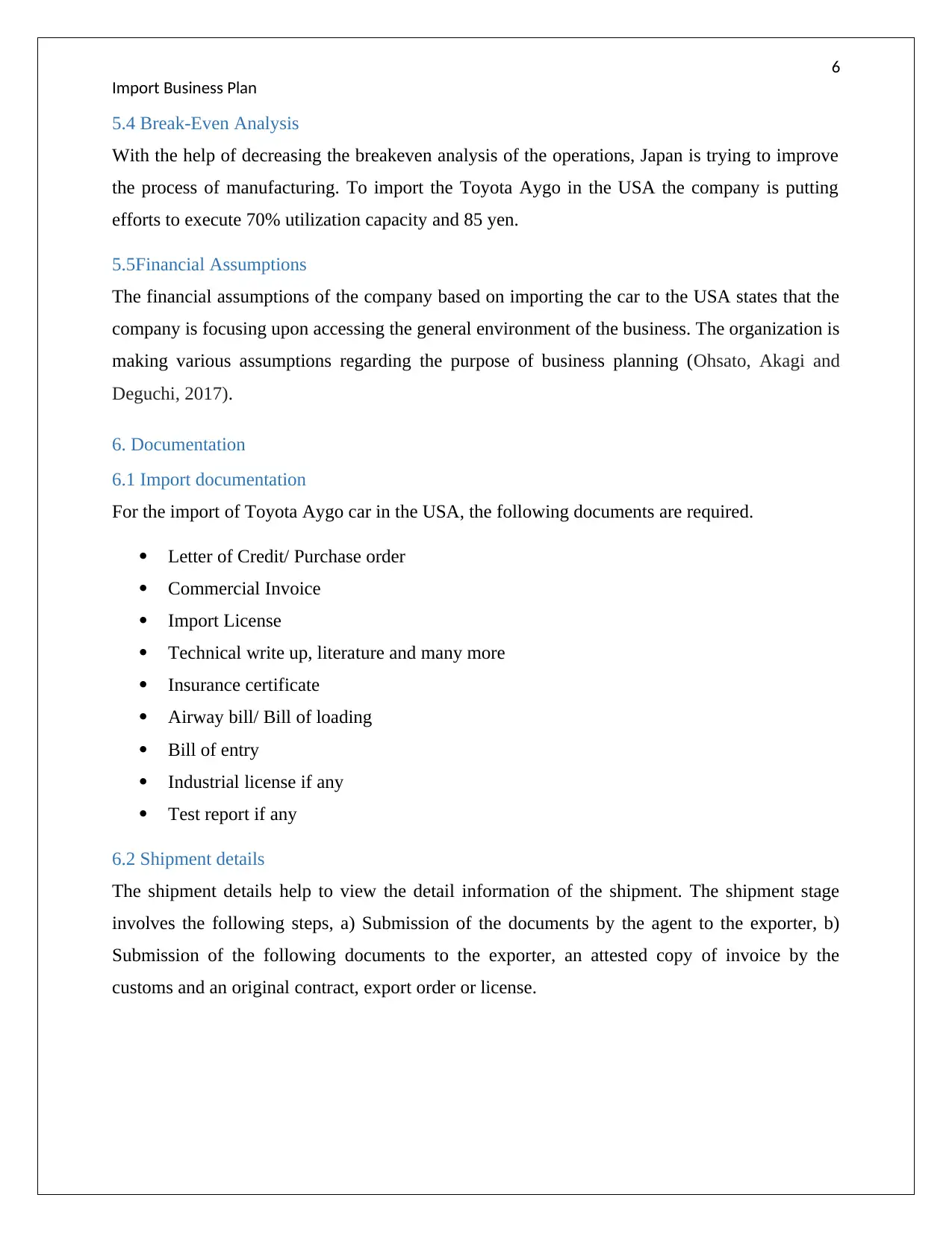
6
Import Business Plan
5.4 Break-Even Analysis
With the help of decreasing the breakeven analysis of the operations, Japan is trying to improve
the process of manufacturing. To import the Toyota Aygo in the USA the company is putting
efforts to execute 70% utilization capacity and 85 yen.
5.5Financial Assumptions
The financial assumptions of the company based on importing the car to the USA states that the
company is focusing upon accessing the general environment of the business. The organization is
making various assumptions regarding the purpose of business planning (Ohsato, Akagi and
Deguchi, 2017).
6. Documentation
6.1 Import documentation
For the import of Toyota Aygo car in the USA, the following documents are required.
Letter of Credit/ Purchase order
Commercial Invoice
Import License
Technical write up, literature and many more
Insurance certificate
Airway bill/ Bill of loading
Bill of entry
Industrial license if any
Test report if any
6.2 Shipment details
The shipment details help to view the detail information of the shipment. The shipment stage
involves the following steps, a) Submission of the documents by the agent to the exporter, b)
Submission of the following documents to the exporter, an attested copy of invoice by the
customs and an original contract, export order or license.
Import Business Plan
5.4 Break-Even Analysis
With the help of decreasing the breakeven analysis of the operations, Japan is trying to improve
the process of manufacturing. To import the Toyota Aygo in the USA the company is putting
efforts to execute 70% utilization capacity and 85 yen.
5.5Financial Assumptions
The financial assumptions of the company based on importing the car to the USA states that the
company is focusing upon accessing the general environment of the business. The organization is
making various assumptions regarding the purpose of business planning (Ohsato, Akagi and
Deguchi, 2017).
6. Documentation
6.1 Import documentation
For the import of Toyota Aygo car in the USA, the following documents are required.
Letter of Credit/ Purchase order
Commercial Invoice
Import License
Technical write up, literature and many more
Insurance certificate
Airway bill/ Bill of loading
Bill of entry
Industrial license if any
Test report if any
6.2 Shipment details
The shipment details help to view the detail information of the shipment. The shipment stage
involves the following steps, a) Submission of the documents by the agent to the exporter, b)
Submission of the following documents to the exporter, an attested copy of invoice by the
customs and an original contract, export order or license.
Paraphrase This Document
Need a fresh take? Get an instant paraphrase of this document with our AI Paraphraser
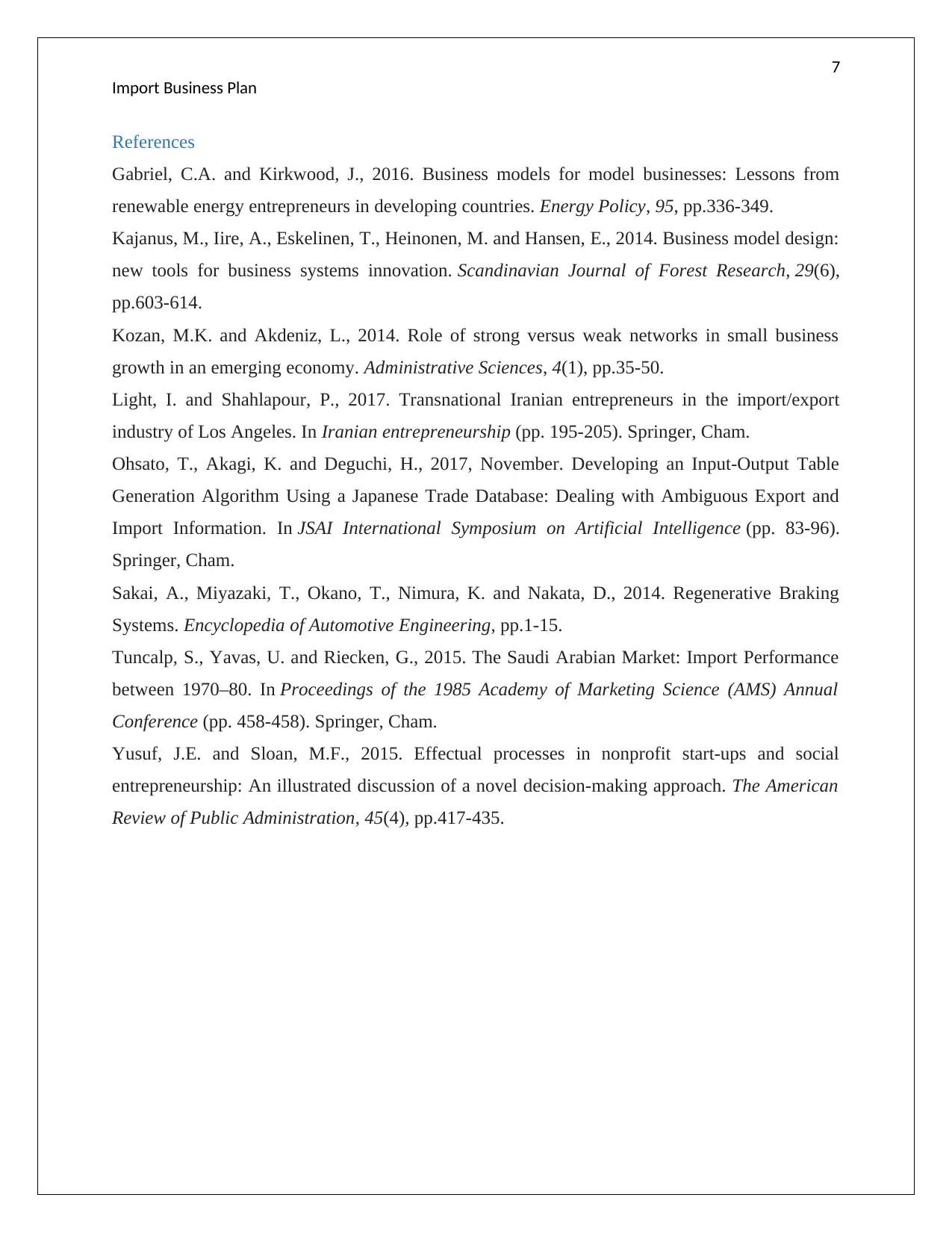
7
Import Business Plan
References
Gabriel, C.A. and Kirkwood, J., 2016. Business models for model businesses: Lessons from
renewable energy entrepreneurs in developing countries. Energy Policy, 95, pp.336-349.
Kajanus, M., Iire, A., Eskelinen, T., Heinonen, M. and Hansen, E., 2014. Business model design:
new tools for business systems innovation. Scandinavian Journal of Forest Research, 29(6),
pp.603-614.
Kozan, M.K. and Akdeniz, L., 2014. Role of strong versus weak networks in small business
growth in an emerging economy. Administrative Sciences, 4(1), pp.35-50.
Light, I. and Shahlapour, P., 2017. Transnational Iranian entrepreneurs in the import/export
industry of Los Angeles. In Iranian entrepreneurship (pp. 195-205). Springer, Cham.
Ohsato, T., Akagi, K. and Deguchi, H., 2017, November. Developing an Input-Output Table
Generation Algorithm Using a Japanese Trade Database: Dealing with Ambiguous Export and
Import Information. In JSAI International Symposium on Artificial Intelligence (pp. 83-96).
Springer, Cham.
Sakai, A., Miyazaki, T., Okano, T., Nimura, K. and Nakata, D., 2014. Regenerative Braking
Systems. Encyclopedia of Automotive Engineering, pp.1-15.
Tuncalp, S., Yavas, U. and Riecken, G., 2015. The Saudi Arabian Market: Import Performance
between 1970–80. In Proceedings of the 1985 Academy of Marketing Science (AMS) Annual
Conference (pp. 458-458). Springer, Cham.
Yusuf, J.E. and Sloan, M.F., 2015. Effectual processes in nonprofit start-ups and social
entrepreneurship: An illustrated discussion of a novel decision-making approach. The American
Review of Public Administration, 45(4), pp.417-435.
Import Business Plan
References
Gabriel, C.A. and Kirkwood, J., 2016. Business models for model businesses: Lessons from
renewable energy entrepreneurs in developing countries. Energy Policy, 95, pp.336-349.
Kajanus, M., Iire, A., Eskelinen, T., Heinonen, M. and Hansen, E., 2014. Business model design:
new tools for business systems innovation. Scandinavian Journal of Forest Research, 29(6),
pp.603-614.
Kozan, M.K. and Akdeniz, L., 2014. Role of strong versus weak networks in small business
growth in an emerging economy. Administrative Sciences, 4(1), pp.35-50.
Light, I. and Shahlapour, P., 2017. Transnational Iranian entrepreneurs in the import/export
industry of Los Angeles. In Iranian entrepreneurship (pp. 195-205). Springer, Cham.
Ohsato, T., Akagi, K. and Deguchi, H., 2017, November. Developing an Input-Output Table
Generation Algorithm Using a Japanese Trade Database: Dealing with Ambiguous Export and
Import Information. In JSAI International Symposium on Artificial Intelligence (pp. 83-96).
Springer, Cham.
Sakai, A., Miyazaki, T., Okano, T., Nimura, K. and Nakata, D., 2014. Regenerative Braking
Systems. Encyclopedia of Automotive Engineering, pp.1-15.
Tuncalp, S., Yavas, U. and Riecken, G., 2015. The Saudi Arabian Market: Import Performance
between 1970–80. In Proceedings of the 1985 Academy of Marketing Science (AMS) Annual
Conference (pp. 458-458). Springer, Cham.
Yusuf, J.E. and Sloan, M.F., 2015. Effectual processes in nonprofit start-ups and social
entrepreneurship: An illustrated discussion of a novel decision-making approach. The American
Review of Public Administration, 45(4), pp.417-435.
1 out of 8
Related Documents
Your All-in-One AI-Powered Toolkit for Academic Success.
+13062052269
info@desklib.com
Available 24*7 on WhatsApp / Email
![[object Object]](/_next/static/media/star-bottom.7253800d.svg)
Unlock your academic potential
Copyright © 2020–2025 A2Z Services. All Rights Reserved. Developed and managed by ZUCOL.





